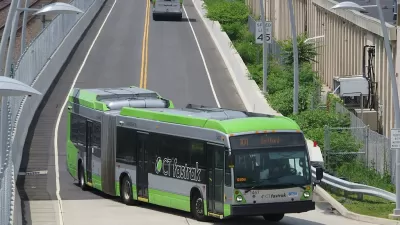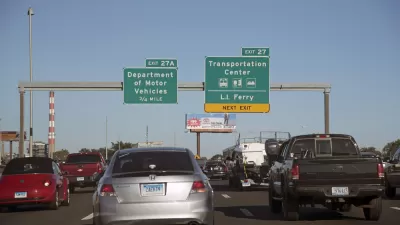A case study of media coverage in Connecticut finds a double standard between the CTFastrak and Interstate 84 projects.
Joseph Cutrufo examines the discrepancies in the scrutiny afforded two transit projects in Connecticut: CTfastrak and the widening of Interstate 84 in Waterbury. Cutrufo begins by noting the similarities between the two projects: "They’re both major transportation projects aimed at improving mobility, both became visible to the traveling public in the spring of 2015, and both cost hundreds of millions of dollars."
Yet despite those similarities, "it seems that the Connecticut Department of Transportation is being asked to justify the amount it’s spending on the bus rapid transit service, while spending on major highway projects seems to be accepted without much media scrutiny."
Seemingly opposed to the CTFastrak, is the Hartford Courant, which has reported and editorialized about a large jump in costs for the system. Cutrofo, however, thinks the focus on increased costs misses much of the point:
"It’s a substantial increase, but that original subsidy estimate is eight years old (though ConnDOT Commissioner Redeker probably shouldn’t have been 'quoting the $10 million figure with no caveats or disclaimers' as recently as 2014 — good sleuthing by the Courant). Since then, ConnDOT had expanded its service plan, which makes the system more useful and convenient, which in turn drives up ridership. And it’s working. Average daily ridership, according to the same article, is over 16,000, about 50 percent higher than the expected 11,200 daily riders."
The article includes by noting the lack of analysis or critique for the 2.7-mile widening project on I-84. In effect, according to Cutrofo, the media and the public declare the following: "No more bottleneck? By any means necessary! More money to subsidize bus riders? Let’s see your numbers."
FULL STORY: Scrutiny for Transit Projects, but Not for Highways

Alabama: Trump Terminates Settlements for Black Communities Harmed By Raw Sewage
Trump deemed the landmark civil rights agreement “illegal DEI and environmental justice policy.”

Planetizen Federal Action Tracker
A weekly monitor of how Trump’s orders and actions are impacting planners and planning in America.

The 120 Year Old Tiny Home Villages That Sheltered San Francisco’s Earthquake Refugees
More than a century ago, San Francisco mobilized to house thousands of residents displaced by the 1906 earthquake. Could their strategy offer a model for the present?

Indy Neighborhood Group Builds Temporary Multi-Use Path
Community members, aided in part by funding from the city, repurposed a vehicle lane to create a protected bike and pedestrian path for the summer season.

Congestion Pricing Drops Holland Tunnel Delays by 65 Percent
New York City’s contentious tolling program has yielded improved traffic and roughly $100 million in revenue for the MTA.

In Both Crashes and Crime, Public Transportation is Far Safer than Driving
Contrary to popular assumptions, public transportation has far lower crash and crime rates than automobile travel. For safer communities, improve and encourage transit travel.
Urban Design for Planners 1: Software Tools
This six-course series explores essential urban design concepts using open source software and equips planners with the tools they need to participate fully in the urban design process.
Planning for Universal Design
Learn the tools for implementing Universal Design in planning regulations.
Clanton & Associates, Inc.
Jessamine County Fiscal Court
Institute for Housing and Urban Development Studies (IHS)
City of Grandview
Harvard GSD Executive Education
Toledo-Lucas County Plan Commissions
Salt Lake City
NYU Wagner Graduate School of Public Service




























